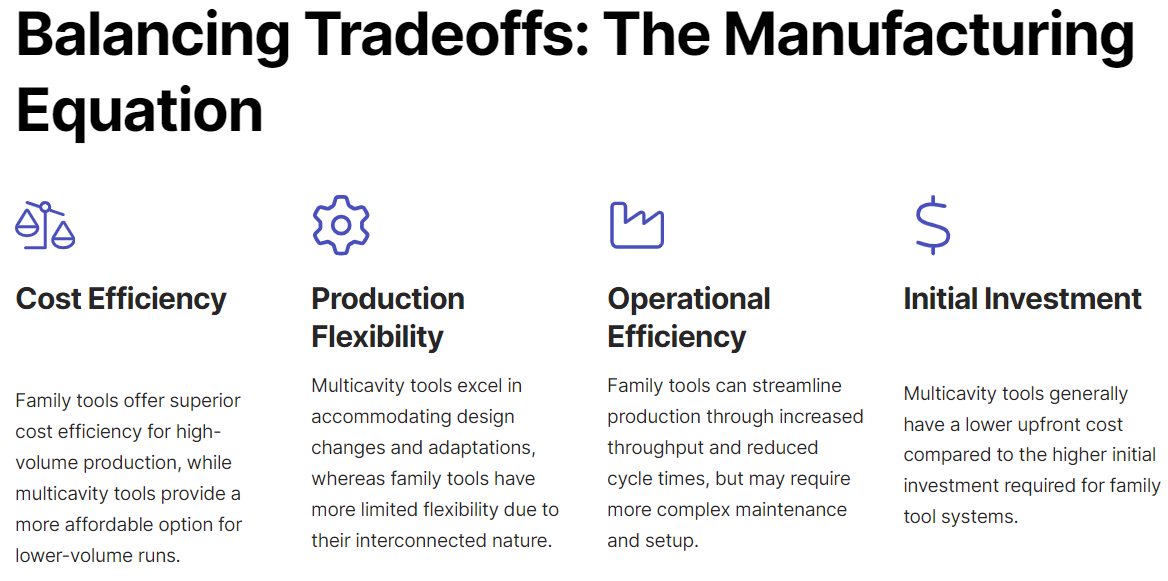Family and Multi-Cavity Tools: The Manufacturing Equation

Family and multi-cavity tools are two different approaches, and the choice between them can significantly impact production, efficiency, cost, and flexibility.
The choice between family tools and multi-cavity tools (also known as 1-Article Tools) can significantly impact production efficiency, cost, and flexibility. This comparative analysis will explore the pros and cons of each approach, helping manufacturers make an informed decision based on their specific needs and production requirements. Let’s take a closer look at each:
You can also read: AI for Enhanced Materials Development and Manufacturing, 96-Cavity Mold Conversion: A Seamless and Beneficial Transition
Family Tools
Family tools are designed to produce multiple related parts or components in a single mold. This approach offers several benefits:
- Efficiency: Family tools enable simultaneous production of multiple parts, reducing cycle times and increasing overall manufacturing efficiency.
- Cost: With family tools, manufacturers can save on tooling costs as they only need to invest in a single mold for multiple parts. Here is important to take into consideration the production peak and how many parts should be produced.
- Flexibility: Family tools allow for easy customization and modification, as different parts can be produced within the same mold.
However, there are also some challenges associated with family tools:
- Complexity: Designing and maintaining family tools can be more complex due to the need to accommodate multiple parts within a single mold. The process development is more complex due to the weight difference between cavities, hence is important to invest in a tool sensoric system, measuring real-time variables like pressure and temperature, for instance, to balance the mold.
- Tooling Changes: If one part in the family tool requires modification or repair, it may affect the production of other parts.
Multi-cavity Tools
Multicavity tools, also known as 1-Article tools, focus on producing a single part or component at a time, but with multiple cavities within the mold. Here are the advantages of multicavity tools:
- High Volume Production: Multi-cavity tools excel in high-volume production scenarios, as they can produce multiple parts simultaneously.
- Consistency: Since each cavity produces the same part, multicavity tools offer consistent part quality and dimensional accuracy.
- Tooling Efficiency: Multi-cavity tools can maximize the use of available space within the mold, resulting in higher tooling efficiency.
However, there are considerations to keep in mind when using multicavity tools:
- Cost: Multicavity tools may require higher upfront investment due to the complexity of the mold design and manufacturing process.
- Flexibility: Modifying or customizing parts produced by multicavity tools can be more challenging compared to family tools. For this issue a prototype phase is recommended.
Balancing the Tradeoffs: The Manufacturing Equation
When deciding between family tools and multicavity tools, manufacturers should consider their specific production requirements and tradeoffs of the manufacturing equation (see the image 2), including:
SPECIFIC PRODUCTION REQUIREMENTS
- Expected production volume
- Part complexity and customization needs
- Tooling and maintenance costs
- Flexibility for future modifications
TRADEOFFS OF THE MANUFACTURING EQUATION
- Cost efficiency
- Production Flexibility
- Operational Efficiency
- Initial Investment

When deciding between family tools and multicavity tools, manufacturers should consider their specific production requirements and tradeoffs of the manufacturing equation
By carefully evaluating these factors, manufacturers can make an informed decision that aligns with their goals and objectives.
In conclusion, both family tools and multicavity tools offer unique advantages and considerations in the manufacturing process. Manufacturers should assess their production requirements and weigh the benefits and challenges of each approach to determine the best fit for their specific needs.
To read more Costs Analysis for Injection Molding: Key Factors and Tips for Costs Reduction
